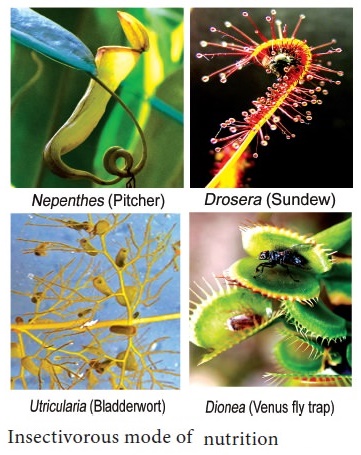Mineral Nutrition | Plant Physiology (Functional Organisation) | Botany - Answer the following questions | 11th Botany : Chapter 12 : Mineral Nutrition
Chapter: 11th Botany : Chapter 12 : Mineral Nutrition
Answer the following questions
Plant Physiology (Functional Organisation)
Mineral Nutrition
6. The nitrogen is present in the atmosphere in huge amount but higher plants fail to utilize it. Why?
Answer:
1.
Plants absorb minerals from the soil along with water with the help of Roots.
Minerals are absorbed as salts.
2.
Nitrogen is present in large quantities in the atmosphere in agaseous from. The
gaseous nitrogen must be fixed in the form of Nitrate salts in the soil to
facilitate absorption by plant roots.
3.
Nitrogen fixation can occur 2 ways by
a)
Non - Biological means (Industrial
process or by lighting)
b)
Biological means (Bacteria /
Cyanobacteria Fungi)
Therefore
higher plants con not utilize the atmospheric Nitrogen.
7. Why is that in certain plants deficiency symptoms appear first in younger parts of the plants while in others, they do so in mature organs?
Answer:
When
deficiency symptoms appear first, we can notice the differences in old and
younger leaves. It is mainly due to mobility of minerals. Based on this, they
are classified into 1. Actively mobile minerals and 2. Relatively
immobile minerals
a) Actively mobile minerals:
Nitrogen, Phosphorus. Potassium, Magnesium, Chlorine, Sodium, Zinc and
Molybdenum.
Deficiency
symptoms first appear on old and senescent leaves due to active movement of
minerals to younger leaves, than the older leaves.
b) Relatively immobile minerals: Calcium,
Sulphur, Iron, Boron and Copper. Here, deficiency symptoms first appear on
young leaves due to the immobile nature of minerals.
8. Plant A in a nutrient medium shows whiptail disease plant B in a nutrient medium shows a little leaf disease. Identify mineral deficiency of plant A and B?
Answer:
Plant
A in nutrient medium shows whiptail
disease: Mineral deficiency is due to Molybdenum.
Plant
B in a nutrient medium shows little leaf
disease: Mineral deficiency is due to Zinc
9. Write the role of nitrogenase enzyme in nitrogen fixation?
Answer:
Nitrogen
fixation is the first step in Nitrogen cycle, during which gaseous nitgrogen
from the atmosphere is fixed. It required nitrogenase enzyme complex nitrogenase is active only in anaerobic
condition. To create this anaerobic condition, a pigment known as leghaemoglobin is synthesized in the
nodules which acts as oxygen scavenger
and removes oxygen.
10. Explain the insectivorous mode of nutrition in angiosperms?
Answer:
Plants
which are growing in nitrogen deficient areas develop insectivorous habit to
resolve nitrogen deificiency.
a.
Nepenthes (Pitcher plant): Pitcher
is a modified leaft and contains digestive enzymes. Rim of the pitcher is
provided with nectar glands and acts as an attractive lid. When insect is
trapped, proteolytic enzymes will digest the insect.
b.
Drosera (Sundew): It consists of
long club shaped tentacles which secrete sticky digestive fluid which looks
like a sundew.
c.
Utricularia (Bladder wort):
Submerged plant in which leaf is modified into a bladder to collect insect in
water.
d.
Dionaea (Venus fly trap): Leaf of
this plant modified into a colourful trap. Two folds of lamina consist of
sensitive trigger hairs and when insects touch the hairs it will close.

INSECTIVOROUS PLANTS

Related Topics